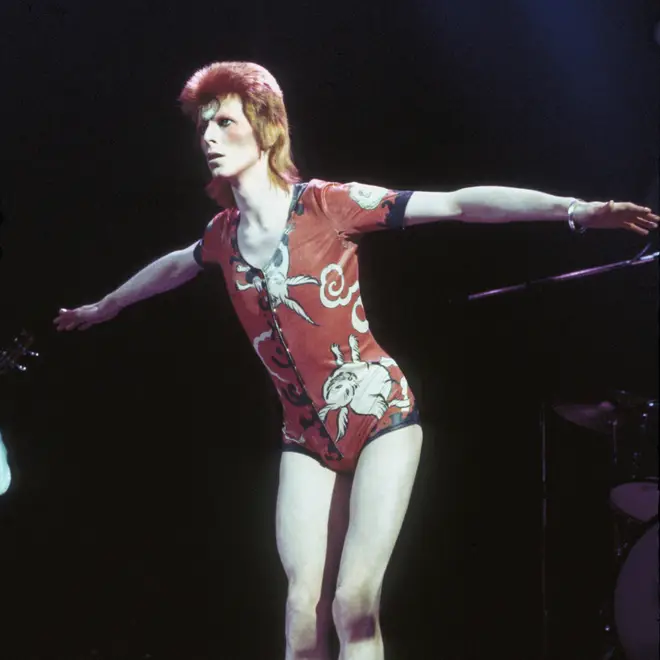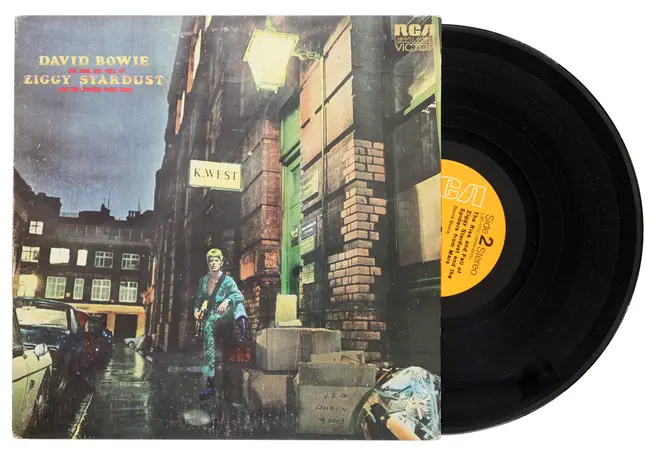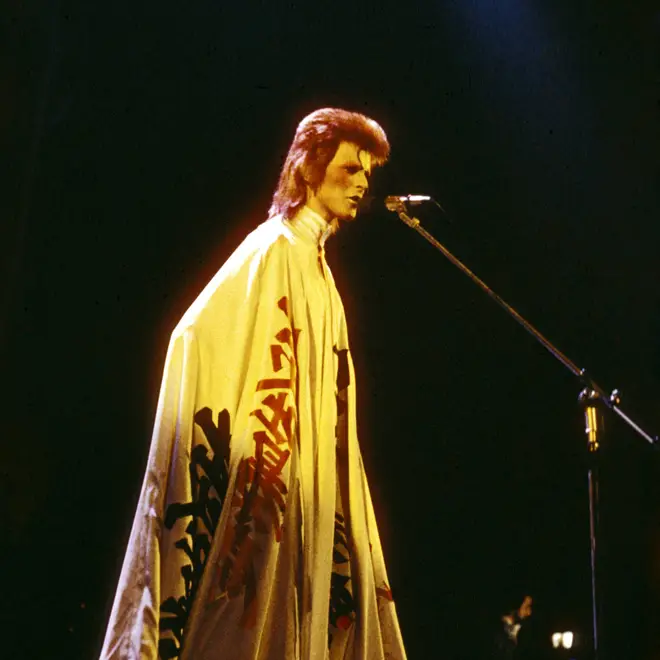On Air Now
Gold's 40 Minutes Non-Stop 7pm - 10pm
3 July 2023, 11:26

David Bowie - Ziggy Stardust: The Global Premiere
The incredible story of when David Bowie killed off his most successful creation at the peak of its popularity.
David Bowie is almost as well-remembered for his ever-shifting musical and personal expressions as he is for his actual songs.
In his first half-decade, he'd already flitted through countless styles – mime, the mod of 'Liza Jane', the Anthony Newley-inspired music hall of his early singles, the psychedelic folk of 'Space Oddity, hard rock of The Man Who Sold the World and refined singer-songwriter vibes of Hunky Dory.
So when he made his proper, lasting breakthrough with The Rise and Fall of Ziggy Stardust and the Spiders from Mars he'd have been forgiven for sticking with the character for a while. After years of trying, he was finally the superstar he was born to be.
David Bowie was never one to stay standing still, though, and on July 3, 1973, he shocked the world by effectively killing off Ziggy Stardust forever.
Of all the shows on this tour, this particular show will remain with us the longest, because not only is it the last show of the tour, but it's the last show that we'll ever do. Thank you.
Ziggy had actually crossed over into Aladdin Sane (described by Bowie as "Ziggy in America" and released three months before his retirement) before David's excursions into soul (Young Americans), electronic experimentation (Station to Station and the Berlin Trilogy) and beyond.
50 years on and with the live document back in cinema, we're taking a closer look at the story of David Bowie's last-ever show as Ziggy Stardust.

David Bowie - Ziggy Stardust (2023 Remaster) [4K Upgrade]
Ziggy was effectively born on January 29, 1972 when Bowie was backed by the Spiders from Mars (guitarist Mick Ronson, bassist Trevor Bolder and drummer Mick Woodmansey) and played the Borough Assembly Hall in Aylesbury – a show attended by early Bowie fan Roger Taylor who had dragged along a certain Freddie Mercury.
"'Ziggy' was my Martian messiah who twanged a guitar," Bowie explained years later He was a simplistic character. I saw him as very simple... fairly like the character Newton I was to do in the film [The Man Who Fell to Earth] later on.
"Someone who dropped down here, got brought down to our way of thinking, and ended up destroying his own self. Which is a pretty archetype storyline."

Right before the tour kicked off, he had told a journalist that the upcoming show would be "quite outrageous, but very theatrical".
He added: "It's going to be costumed and choreographed, quite different to anything anyone else has tried to do before."
While Mick Ronson was very much up for getting dolled up and playing with makeup, the rest of the band needed some convincing.

David Bowie - Hang On To Yourself (Live, 1973)
"To get the band into that stuff I had to tell them that the girls would really love it," Bowie said.
"Thank god it paid off... they never had so many women in their lives and so they got tartier and tartier."
So Bowie more formally unveiled his Ziggy persona at the next show on February 10 at the Toby Jug pub in Tolworth. These early gigs weren't particularly well-attended, but as word spread, things got bigger and bigger.

David Bowie - Starman (Top Of The Pops, 1972)
Then came performances of 'Starman' on Lift-Off With Ayesha and, most famously, Top of the Pops, and nothing was the same again.
After a few months, Bowie took a short break and ramped up the show even more, working on the concept, setlist, outfits and routines returning at the Rainbow Theatre in London on August 19 where Bowie was apparently even being billed as Ziggy Stardust.
Pianist Nicky Graham played a few shows, before Mike Garson was added to the lineup when the tour went to America.

While the Ziggy Stardust live show picked up pace, The Rise and Fall of Ziggy Stardust and the Spiders from Mars album itself was released on June 16, 1972.
In truth, the Ziggy concept on the record is pretty loose. He gets introduced on 'Moonage Daydream', celebrated and damned in 'Ziggy Stardust', while 'Starman', 'Lady Stardust' and 'Star' push forward the "story", before his ultimate demise in 'Rock 'n' Roll Suicide'.
It was Bowie's most successful album to date by far, going to number 5 in the UK and effectively making him the sort of star he'd been pretending to be for years.

David Bowie - Changes (Live) [2023 Remaster] [4K Upgrade]
But 18 months of touring as the character had been wearing Bowie down. He felt exhausted, a little insane, and maybe most importantly creatively bored.
What's more, these ambitious shows were so expensive to put on that Bowie's label RCA didn't fancy putting up the money for a third US jaunt.
So at the Hammersmith Odeon to a packed house of 3,500 fans, during the last UK show of what was actually the Aladdin Sane tour, Bowie decided to kill off Ziggy.

It all happened near the end of the set – which had featured Jeff Beck as a special guest on the medley of 'The Jean Genie' and a cover of The Beatles' 'Love Me Do', and Chuck Berry's 'Round and Round'.
After Beck departed the stage, Bowie made that fateful announcement that it was "the last show that we'll ever do", before kicking into – what else – 'Rock 'n' Roll Suicide'.

David Bowie - The Farewell Speech (2023 Remaster) [4K Upgrade]
With enough ambiguity suggesting that Bowie was perhaps even retiring from music (indeed a press release from Bowie's people suggested it was his final ever concert), you can hear just how stunned the crowd are by the live recordings.
Incredibly, so too was much of his backing band. Mick Ronson had been given a heads up, but Woody and Bolder were as surprised as anyone in the building by the announcement.
The full setlist of the final Ziggy Stardust show was as follows:

David Bowie - Ziggy & Me (Woody Woodmansey)
It's worth noting how the setlist was much more than just a retread of the Ziggy album.
While it had five tracks from that album, it also featured the same number from his earlier records, plus another five songs from Aladdin Sane.
It also featured the aforementioned Beatles and Chuck Berry covers, plus Jacques Brel's 'My Death' and The Velvet Underground's 'White Light/White Heat', showing the breadth of Bowie's influences.

David Bowie – My Death (Live, 1973)
Thankfully the whole show had been recorded and filmed by DA Pennebaker, though camera and lighting limitations meant that it wasn't anywhere near as good as his 1960s films like the Bob Dylan documentary Dont Look Back.
In fact, the whole project stayed on the shelf for years after the show and after the "death" of Ziggy, eventually being cleaned up and released as Ziggy Stardust and the Spiders from Mars in 1979, with an accompanying album Ziggy Stardust: The Motion Picture following in 1983.
In 2023, to mark the 50th anniversary, a 4K reissue of the film was released in cinemas, with the new cut even featuring the Jeff Beck numbers that never featured before.

Why did you kill Ziggy?
While he was happy to play some of its songs in concert, for years Bowie would shy away from the Ziggy persona.
Whether or not they had a name, he shifted from style to style in the following years and decades, be it Halloween Jack, the blue-eyed soul boy of Young Americans, The Thin White Duke or the blonde poptastic Bowie of Let's Dance.
Some people simply refused to let Ziggy go. In the '00s Bowie would frequently tell the story of a French journalist who was interviewing him during the Tin Machine days who – no matter what Bowie said – just couldn't stop exclaiming "Why did you kill Ziggy?!".